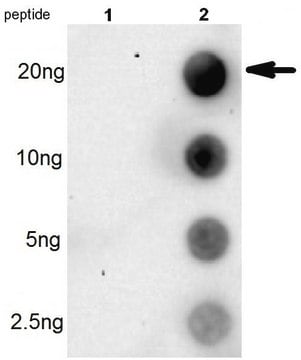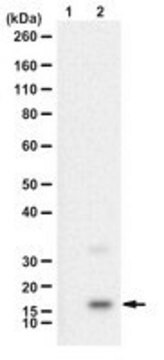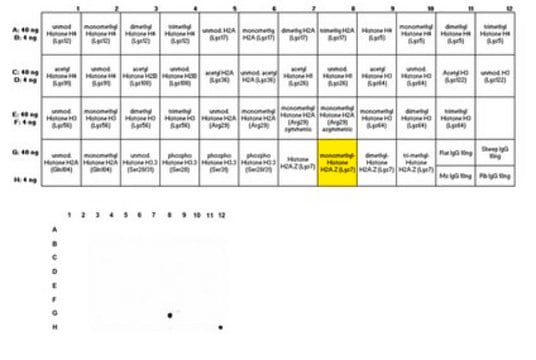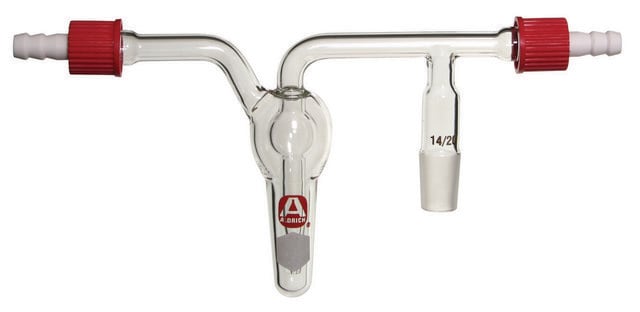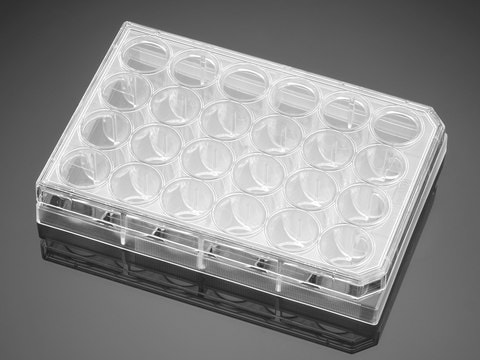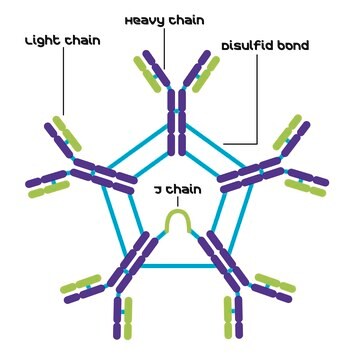추천 제품
생물학적 소스
rabbit
Quality Level
결합
unconjugated
항체 형태
purified antibody
항체 생산 유형
primary antibodies
클론
polyclonal
분자량
calculated mol wt 15.51 kDa
종 반응성
human
포장
antibody small pack of 100 μg
기술
dot blot: suitable
western blot: suitable
동형
IgG
에피토프 서열
N-terminal
단백질 ID 수납 번호
UniProt 수납 번호
배송 상태
ambient
타겟 번역 후 변형
trimethylation (Lys4), histaminylation (Gln5)
유전자 정보
human ... HIST3H3(8290)
일반 설명
Histone H3.1t (UniProt: Q16695; also known as H3/t, H3t, H3/g) is encoded by the HIST3H3 (also known as H3FT) gene (Gene ID: 8290) in human. Histones are highly conserved basic nuclear proteins that are responsible for the nucleosome structure of chromatin in eukaryotes. They play a central role in transcription regulation, DNA repair, DNA replication and chromosomal stability. DNA accessibility is regulated via a complex set of post-translational modifications of histones, also called histone code, and nucleosome remodeling. Two molecules of each of the four core histones (H2A, H2B, H3, and H4) form an octamer, around which DNA is wrapped in repeating units, called nucleosomes, which limits DNA accessibility to the cellular machineries that require DNA as a template. Histone H3 features a main globular domain and a long N-terminal tail, which protrudes from the globular nucleosome core and can undergo several different types of epigenetic modifications that influence cellular processes. The amino-terminal tails of histone proteins are subject to posttranslational modifications, including acetylation and methylation, which recruit downstream regulatory factors, influence chromatin structure, and are critical determinants of transcription. Acetylation of histone H3 occurs at several different lysine positions in the histone tail and is performed by a family histone acetyltransferases. Acetylation is generally associated with transcriptional activity and methylation of lysine and arginine residues can either activate or repress depending on the residue modified. There is a significant correlation between acetylation of histones H3 in promoter regions and transcriptional activity. The presence of H3K4me3 has been correlated with transcriptionally active promoters of genes and its levels positively correlate with gene expression levels. H3K4me3 has been implicated in a number of nuclear processes, including Pol II-mediated transcription, pre-mRNA splicing, DNA recombination, and DNA repair. Histaminylation of glutamine 5 on histone H3 (H3Q5Histaminyl) is recently identified as a permissive post-translational modification that coexists with adjacent lysine 4 trimethylation. (Ref.: Zhao, S., et al. (2021). Proc. Natl. Acad. Sci. USA. 118(6):e2016742118; Diehl , KL., and Muir, TW. (2020). Nat. Chem. Biol. 16; 620-629; Bernstein, BE., et al. (2002). Proc. Natl. Acad. Sci. USA. 99(13);8695-8700).
특이성
This rabbit polyclonal antibody specifically detects Histone H3.1 with trimethylated lysine 4 and histaminylated glutamine 5.
면역원
KLH-conjugated linear peptide corresponding to 10 amino acids from the N-terminal region of human Histone H3.1 with trimethylated lysine 4 and histaminylated glutamine 5.
애플리케이션
Quality Control Testing
Evaluated by DOT Blot analysis with K3K4me3Q5Histaminyl peptide.
Dot Blot Analysis: A 1:1,000 dilution of this antibody detected H3K4me3Q5Histaminyl peptide, but not the unmodified H3Q5 peptide.
Tested Applications
Western Blotting Analysis: A 1:2,000 dilution from a representative lot detected Histone H3.1 trimethylated on lysine 4 and histaminylated on glutamine 5 (H3K4me3Q5Histaminyl) in RN46A, KU812, SK-N-SH & HEK293T whole cell lysates. (Data courtesy of Dr. Ian Maze s Lab, Icahn School of Medicine at Mount Sinai, New York).
Note: Actual optimal working dilutions must be determined by end user as specimens, and experimental conditions may vary with the end user
Evaluated by DOT Blot analysis with K3K4me3Q5Histaminyl peptide.
Dot Blot Analysis: A 1:1,000 dilution of this antibody detected H3K4me3Q5Histaminyl peptide, but not the unmodified H3Q5 peptide.
Tested Applications
Western Blotting Analysis: A 1:2,000 dilution from a representative lot detected Histone H3.1 trimethylated on lysine 4 and histaminylated on glutamine 5 (H3K4me3Q5Histaminyl) in RN46A, KU812, SK-N-SH & HEK293T whole cell lysates. (Data courtesy of Dr. Ian Maze s Lab, Icahn School of Medicine at Mount Sinai, New York).
Note: Actual optimal working dilutions must be determined by end user as specimens, and experimental conditions may vary with the end user
Anti-H3K4me3Q5histaminyl, Cat. No. ABE2605, is a rabbit polyclonal antibody that detects Histone H3.1 trimethylated on lysine 4 and histaminylated on glutamine 5 and is tested for use in Dot Blot and Western Blotting.
물리적 형태
Purified rabbit polyclonal antibody in buffer containing 0.1 M Tris-Glycine (pH 7.4), 150 mM NaCl with 0.05% sodium azide
저장 및 안정성
Recommended storage: +2°C to +8°C.
기타 정보
Concentration: Please refer to the Certificate of Analysis for the lot-specific concentration.
면책조항
Unless otherwise stated in our catalog or other company documentation accompanying the product(s), our products are intended for research use only and are not to be used for any other purpose, which includes but is not limited to, unauthorized commercial uses, in vitro diagnostic uses, ex vivo or in vivo therapeutic uses or any type of consumption or application to humans or animals.
적합한 제품을 찾을 수 없으신가요?
당사의 제품 선택기 도구.을(를) 시도해 보세요.
Storage Class Code
12 - Non Combustible Liquids
WGK
WGK 1
Flash Point (°F)
Not applicable
Flash Point (°C)
Not applicable
시험 성적서(COA)
제품의 로트/배치 번호를 입력하여 시험 성적서(COA)을 검색하십시오. 로트 및 배치 번호는 제품 라벨에 있는 ‘로트’ 또는 ‘배치’라는 용어 뒤에서 찾을 수 있습니다.
자사의 과학자팀은 생명 과학, 재료 과학, 화학 합성, 크로마토그래피, 분석 및 기타 많은 영역을 포함한 모든 과학 분야에 경험이 있습니다..
고객지원팀으로 연락바랍니다.